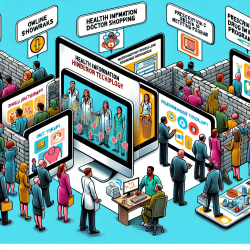Introduction
In today's digital age, the integration of Health Information Technology (HIT) is revolutionizing healthcare practices, offering innovative solutions to persistent challenges such as doctor shopping. Doctor shopping, the practice of visiting multiple physicians to obtain multiple prescriptions, poses significant risks, particularly in the context of the opioid crisis. The systematic review titled "Health Information Technology and Doctor Shopping: A Systematic Review" provides critical insights into how HIT can be leveraged to mitigate this issue.
Understanding the Role of HIT
The research highlights that multiple HIT mechanisms exist to control doctor shopping, each contributing uniquely to reducing prescription misuse. These mechanisms include:
- Prescription Drug Monitoring Programs (PDMPs): State-run databases that track prescriptions of controlled substances, allowing healthcare providers to monitor patient prescriptions across different providers.
- Health Information Exchanges (HIEs): Facilitate the secure exchange of health information across different healthcare organizations, enhancing the ability to track patient prescription histories.
- PharmaCloud: A system used outside the U.S. that enables physicians to access patients' medication records to prevent drug shopping.
- Smart Cards: Carry information about a patient's prescribed medications, helping to avoid duplicate prescriptions.
Key Findings and Implications
The systematic review identifies several key interventions and outcomes associated with the use of HIT in controlling doctor shopping:
- Reduced Shopping and Mortality: The implementation of PDMPs and other HIT solutions has been associated with a decrease in doctor shopping and overdose mortality.
- Facilitators: Government and prescriber support are crucial facilitators for the successful implementation of HIT solutions.
- Barriers: Challenges such as data sharing limitations and non-mandatory participation in HIT programs hinder the effectiveness of these solutions.
The research underscores the importance of robust data sharing agreements and mandatory participation in HIT programs to maximize their potential in curbing doctor shopping.
Encouraging Further Research and Implementation
While the review provides valuable insights, it also highlights the need for further research to explore high-strength studies in this area. Practitioners are encouraged to delve deeper into the findings and consider how they can implement HIT solutions in their practices to improve patient outcomes.
By leveraging HIT, practitioners can play a pivotal role in addressing the issue of doctor shopping, ultimately contributing to better healthcare outcomes and reducing the risks associated with prescription drug misuse.
Conclusion
The integration of HIT in healthcare practices offers a promising pathway to controlling doctor shopping. As practitioners, embracing these technologies and advocating for comprehensive data sharing and mandatory participation in HIT programs can significantly enhance patient safety and care quality.
To read the original research paper, please follow this link: Health Information Technology and Doctor Shopping: A Systematic Review.










